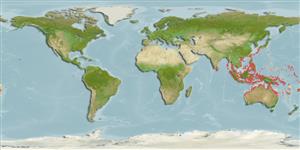Common names from other countries
Environment: milieu / climate zone / depth range / distribution range
Ekologi
Berasosiasi dengan karang; kisaran kedalaman 0 - 6 m (Ref. 99823). Tropical
Indo-West Pacific.
Length at first maturity / Size / Weight / umur
Maturity: Lm ? range ? - ? cm Max length : 12.0 cm CW jantan/; (Ref. 343)
Surface of carapace smooth, sometimes with low pubescence; ridges distinct; front with 6 lobes, median 4 lobes truncate, lateral 2 lobes rounded. Color: usually bright red overall, but sometimes green, or with a mixture of red and green. Easily distinguished by its spinose palm and the bright red coloration.
Also caught by nets. Intertidal to subtidal (Ref. 106854).
Life cycle and mating behavior
Kematangan | Reproduksi, perkembang biakan | Pemijahan | telur-telur | Fecundity | Larva
Members of the order Decapoda are mostly gonochoric. Mating behavior: Precopulatory courtship ritual is common (through olfactory and tactile cues); usually indirect sperm transfer.
rujukan utama
Acuan | Koordinator | mitra
Ng, P.K.L. 1998. (Ref. 343)
Status IUCN Red List (Ref. 130435)
status CITES (Ref. 108899)
Not Evaluated
Not Evaluated
penggunaan manusia
Perikanan: komersial
| FishSource |
Alat, peralatan
Sumber internet
Estimates based on models
Preferred temperature
(Ref.
115969): 24.9 - 29.3, mean 28.6 (based on 2437 cells).
keancaman
Low vulnerability (10 of 100).
kategori harga
Unknown.
